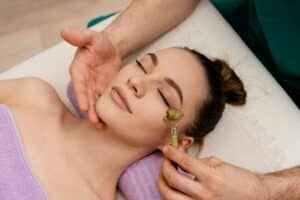Myotherapy presents itself as a prospective path, providing relaxation methods that have the potential to bring significant benefits to those dealing with sleep apnea. This article explores the intricacies of myotherapy, examining specific exercises designed to naturally alleviate symptoms associated with sleep apnea. Join us on an exploration of diverse myotherapy techniques, each carrying the promise of unlocking a night of more serene and rejuvenating sleep.
Tongue Touches: Enhancing Mind-Body Connection for Improved Breathing
Tongue touches, a foundational myotherapy exercise, go beyond the physical realm, delving into the intricate connection between the mind and body to improve breathing and mitigate sleep apnea symptoms. The simplicity of this technique belies its profound impact, as individuals gently touch specific points in their mouths, stimulating muscle engagement that extends far beyond the tongue.
The core of tongue touches is centered around developing mindfulness in breathing patterns. By intentionally engaging in the action of touching the tongue to specific points, individuals elevate their consciousness of each breath. This increased awareness nurtures a profound comprehension of one’s respiratory patterns, a fundamental element in the effective management of sleep apnea.
Incorporating tongue touches into a nightly routine becomes a ritual of self-awareness and relaxation. As the mind-body connection strengthens through regular practice, individuals embark on a journey toward improved breathing, reduced sleep apnea symptoms, and a more serene sleep experience.
Balloon Inflation: Guiding Breath for Respiratory Strength
Balloon inflation, a foundational myotherapy technique, is a beacon of hope for those navigating the challenges of sleep apnea. This exercise encourages individuals to simulate the inflation of a balloon while prioritizing deep, controlled breaths. By engaging in this rhythmic practice, respiratory muscle strength is enhanced, and diaphragmatic breathing is promoted.
The deliberate focus on breath guides individuals towards optimal respiratory patterns, a critical component in the battle against sleep apnea. As an accessible and empowering exercise, balloon inflation not only contributes to the strengthening of the respiratory system but also instills a sense of control over one’s breath—a key element in achieving a more tranquil and uninterrupted night’s sleep. Incorporating this myotherapy technique into a daily routine unveils a path to respiratory strength and improved sleep quality.
‘The orofacial myofunctional therapy (OMT), or oropharyngeal exercises, with one of the focal points in the promotion of changes in dysfunctional upper airway muscles, was
proposed with success for reducing OSA severity and associated symptoms in adults.’
– de Felício, C. M., da Silva Dias, F. V., & Trawitzki, L. V. V. (2018). Obstructive sleep apnea: focus on myofunctional therapy. Nature and science of sleep, 271-286. URL: https://www.tandfonline.com/doi/pdf/10.2147/NSS.S141132

Yogurt Suction: Strengthening Swallowing Mechanism for Airway Health
A unique myotherapy technique, yogurt suction is more than a simple exercise; it’s a targeted approach to enhancing airway health. By gently engaging in suction, individuals stimulate the muscles involved in swallowing, fortifying the swallowing mechanism crucial for maintaining an open airway during sleep. This exercise extends beyond sleep apnea management, promoting overall oral and throat health.
Consistent incorporation of yogurt suction into a routine not only enhances sleep quality but also promotes the overall health of the entire oral cavity. As a holistic strategy within myotherapy, yogurt suction empowers individuals with a proactive means to fortify their airway defenses, aligning with the broader goal of fostering comprehensive respiratory health.
Tongue Presses: Empowering Tongue Muscles for Airway Maintenance
Sleep apnea frequently arises due to insufficient tongue muscle tone, rendering tongue presses a valuable exercise within the realm of myotherapy. By pressing the tongue against the roof of the mouth, individuals stimulate and strengthen these muscles. This technique plays a role in improving tongue positioning while asleep, diminishing the chances of airway blockage. As an empowering and targeted technique, tongue presses provide individuals with a proactive means to address a specific factor contributing to sleep apnea.
Integrating this exercise into a daily routine not only aids in preventing airway blockages but also promotes overall tongue health, aligning with the broader goal of enhancing respiratory well-being.
Teeth Touches: Finding Stability in Jaw Position for Respiratory Ease
Myotherapy for sleep apnea extends its benefits to jaw stability through teeth touches, a nuanced yet impactful exercise. Engaging in a gentle pressing of the teeth together, this method encourages the correct alignment of the jaw. Improved jaw positioning not only enhances breathing but also reduces the strain on surrounding muscles, fostering a more relaxed state conducive to restful sleep. Beyond its specific application for sleep apnea management, teeth touches provide individuals with a tool for addressing broader issues related to jaw alignment and muscle tension. By incorporating this exercise into a nightly routine, individuals pave the way for a more comfortable and serene sleep environment.
Uvula Raises: Elevating the Soft Palate for Unobstructed Breathing
Uvula raises, a key myotherapy technique, focuses on strengthening the muscles surrounding the uvula to address one of the contributors to sleep apnea. The uvula, a small tissue at the back of the throat, can obstruct airflow during sleep, leading to disruptions in breathing patterns.
Integrating uvula raises into a nightly regimen involves individuals participating in specific exercises designed to improve the strength and endurance of the muscles surrounding the uvula. This, in turn, helps prevent the uvula from collapsing into the airway, promoting unobstructed breathing and reducing the likelihood of sleep apnea symptoms.
Uvula raises extend beyond their particular use in managing sleep apnea, presenting a nuanced strategy for enhancing respiratory well-being. This approach furnishes individuals with a proactive method to tackle concerns related to the soft palate. As individuals embrace this myotherapy technique, they not only target a specific contributor to sleep apnea but also foster overall well-being in the crucial realm of upper airway health.
Party Horn: Playful Expansion for a Resilient Airway
Adding a touch of playfulness to myotherapy, the party horn exercise involves mimicking the action of blowing a party horn. This playful yet purposeful technique targets the muscles in the back of the throat, promoting their strength and flexibility. As these muscles become more resilient, the airway expands, mitigating the occurrences of sleep apnea episodes. Beyond its specific application, the party horn technique provides individuals with a lighthearted approach to respiratory health. By integrating this practice into your nightly rituals, you will not only target a particular facet of sleep apnea but also introduce a touch of pleasure into your endeavor for enhanced respiratory health and better sleep quality.
Myotherapy unfolds a gentle yet powerful embrace for you, offering relief from sleep apnea. These relaxation techniques, ranging from tongue touches to uvula raises, empower you to play an active role in enhancing your sleep quality. By incorporating myotherapy into your routine, you can find a path to relaxation, alleviate sleep apnea symptoms, and enjoy a more restful night’s sleep. Embrace the transformative potential of myotherapy and embark on a journey towards a rejuvenated and revitalized sleep experience tailored to you.



